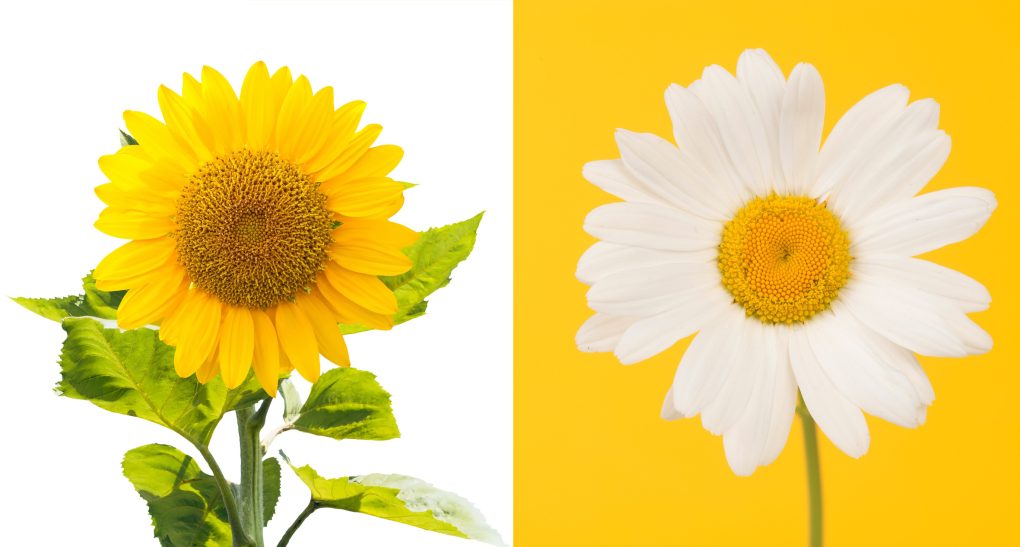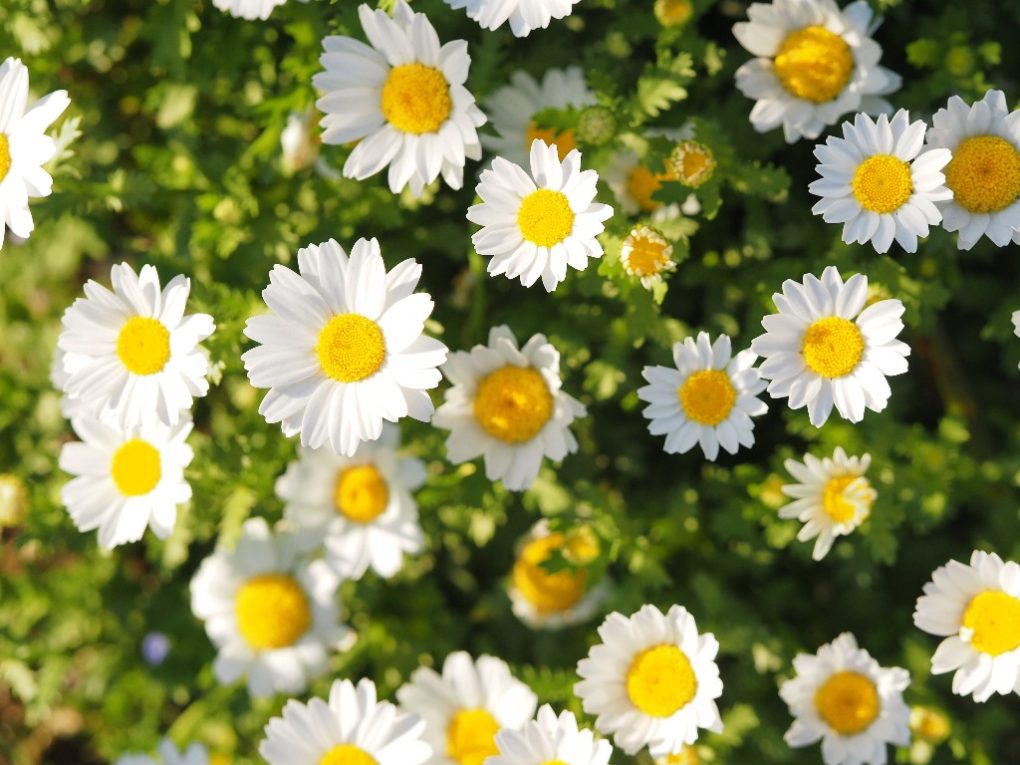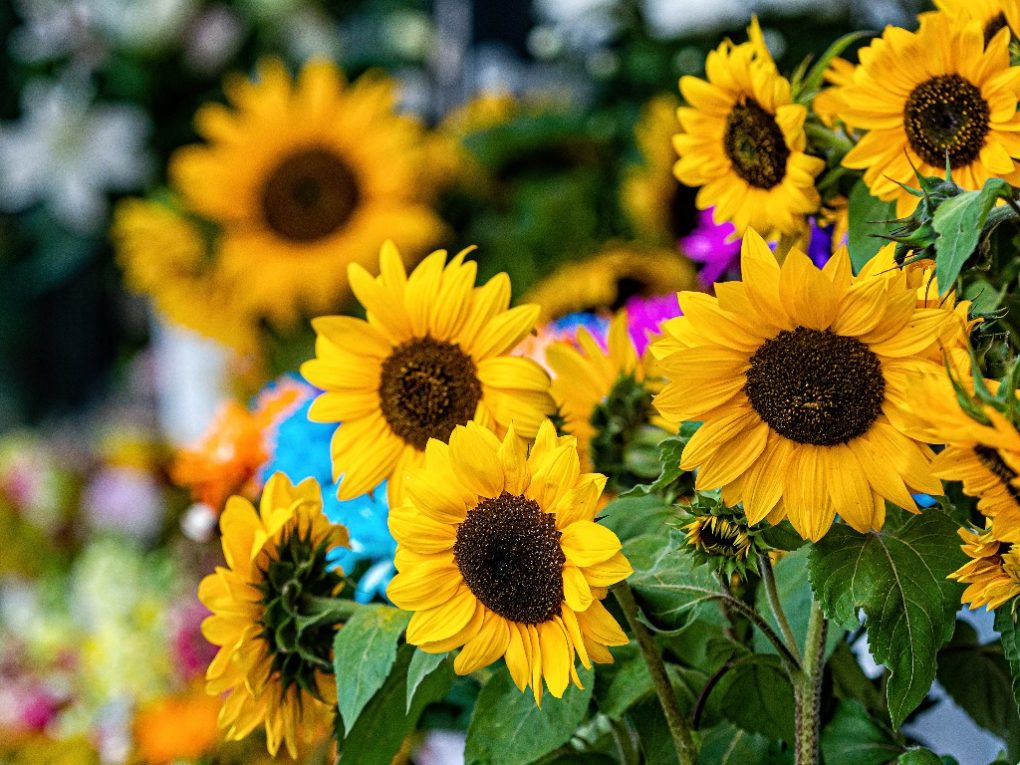Sunflower vs. Daisy: Differences between Sunflowers and Daisy
Sunflowers and daisies are popular garden flowers known for their bright, cheerful blooms. Here are some differences between the two:

- Appearance: Sunflowers are large, tall plants that produce a single large flower head on a long stem. The flower head comprises many small flowers surrounded by yellow or brown petals. On the other hand, Daisies are smaller plants with multiple small flower heads on short stems. Each flower head has many small white or yellow petals surrounding a yellow center.
- Growing conditions: Sunflowers prefer full sun and well-drained soil and can grow up to 10 feet (3 meters) tall. Daisies are also sun-loving plants but prefer slightly cooler temperatures and can tolerate a wider range of soil conditions.
- Uses: Sunflowers are often grown for their edible seeds, which can be roasted and eaten as a snack or used to make oil. They are also popular as ornamental plants and are often used in cut flower arrangements. Daisies are mainly grown for their ornamental value and are often used in borders or as a ground cover in gardens.
- Symbolism: Sunflowers are often associated with happiness, positivity, and loyalty. They are also a popular symbol of the summer season. Daisies are often associated with innocence, purity, and new beginnings.
Table of Contents
Differences Between Sunflowers and Daisies
Physical Characteristics
Sunflowers and daisies are beautiful flowers, but they have some physical differences. Here are some of the key differences:
- Size: Sunflowers are generally much larger than daisies. Sunflowers can grow up to 10 feet (3 meters) tall and have a large flower head up to 1 foot (30 cm) in diameter. On the other hand, Daisies are usually only a few inches (5-10 cm) tall and have smaller flower heads.
- Flower Head: Sunflowers have a single large head comprising many small flowers arranged in a circular pattern. The flower head is surrounded by large, broad petals, typically yellow or orange. Daisies, conversely, have multiple smaller flower heads that are usually white or yellow. Each flower head comprises many small petals arranged around a central disk.
- Stem: Sunflowers have a strong, sturdy stem that can support the weight of the large flower head. On the other hand, Daisies have a more delicate stem that is usually shorter and thinner.
- Leaves: Sunflowers have large, broad leaves arranged in a spiral pattern around the stem. Daisies have smaller, more narrow leaves that are usually arranged in a rosette at the base of the plant.
- Growing Habit: Sunflowers are usually grown as single plants with a single large flower head. On the other hand, Daisies are often grown in clumps or clusters, with multiple smaller flower heads growing on each stem.
Growth Cycles
Sunflowers and daisies have different growth cycles, which include several stages from seed to mature plant. Here are the key differences:
- Germination: Sunflowers and daisies begin their life cycle as seeds germinate when planted in moist soil. Sunflower seeds usually germinate within 7-10 days, according to HGTV, while daisy seeds may take up to two weeks to germinate.
- Seedling Stage: After germination, sunflower and daisy seeds produce small leaves and fragile stem seedlings. Sunflower seedlings grow relatively quickly and are usually ready to be transplanted after about two weeks. Daisy seedlings are more delicate and require a little more time before they can be transplanted, usually after 3-4 weeks.
- Vegetative Growth: Once transplanted, sunflowers and daisies enter a period of vegetative growth, during which they produce more leaves and develop a stronger stem. Sunflowers grow rapidly and reach up to 3-4 feet (1 meter) tall in just a few weeks. Daisies grow more slowly and usually reach a height of only a few inches during this stage.
- Flowering Stage: Sunflowers typically start to produce their large, characteristic flower heads about 70-90 days after planting, depending on the variety. Daisies usually start to flower around 8-10 weeks after planting, producing smaller flower heads.
- Seed Production: After flowering, sunflowers and daisies produce seeds that can be harvested for eating, replanting, or saving for future use. Sunflowers produce many seeds in a single large flower head, while daisies produce smaller seeds in multiple flower heads.
Genus
Sunflowers and daisies are also different in terms of their genus, which refers to their taxonomic classification. Here are some key differences:
- Genus: Sunflowers belong to the genus Helianthus, which is part of the Asteraceae family. The name “Helianthus” comes from the Greek words “helios” meaning sun, and “anthos” meaning flower, reflecting the plant’s large, sunny flower heads. Daisies belong to the genus Bellis, also part of the Asteraceae family. The name “Bellis” comes from the Latin word for pretty or handsome, reflecting the flower’s beauty.
- The number of species: The Helianthus genus contains around 70 different species of sunflowers, including annuals, perennials, and biennials. On the other hand, the Bellis genus contains only 15-20 species of daisies, mostly perennials.
- Distribution: Sunflowers are native to North and Central America but are now widely cultivated worldwide for their seeds, oil, and ornamental value. Daisies are native to Europe and Asia but have also been widely cultivated and naturalized in other parts of the world.
- Morphology: Sunflowers and daisies have distinct morphological differences that reflect their taxonomic classification. For example, sunflowers have disc florets and ray florets, characteristic of the Asteraceae family, while daisies have only disc florets.
Pollination
Sunflowers and daisies are different in terms of their pollination strategies. Here are the key differences:

- Flower structure: Both sunflowers and daisies are members of the Asteraceae family and have composite flower heads made up of many small individual flowers. Sunflowers have disk florets (small, tubular flowers in the center) and ray florets (large, petal-like flowers around the edge), while daisies have only disk florets.
- Pollination mechanism: Sunflowers and daisies have different pollination mechanisms. Sunflowers rely on cross-pollination, which occurs when pollen from one flower is transferred to another on a different plant by insects like bees, butterflies, and beetles. The large, showy ray florets of sunflowers serve as a visual cue to attract pollinators to the flower head, while the disk florets produce nectar and pollen as a reward for the visiting insects.
Daisies, on the other hand, are mostly self-fertile, meaning they can pollinate themselves without the help of insects. However, they can also be pollinated by insects like bees and flies, which visit the flower heads to feed on nectar and pollen.
- Pollen production: Sunflowers produce a lot of pollen, which the visiting insects disperse as they move from flower to flower. Daisies, in contrast, produce less pollen and rely more on self-pollination.
Seeds
Sunflowers and daisies are different in terms of their seeds. Here are the key differences:
- Seed size: Sunflower seeds are much larger than daisy seeds. Sunflower seeds are typically about 1-2 cm long and wide, while daisy seeds are usually less than 1 cm long and narrow.
- Seed dispersal: Sunflower seeds are dispersed by various animals, including birds, rodents, insects, and humans, who harvest them for food and oil. The seeds are encased in a hard outer shell and can be difficult to extract. On the other hand, Daisy seeds are typically dispersed by wind, as they are small and lightweight.
- Edible uses: Sunflower seeds are commonly consumed by humans as a snack or used for oil production. They are rich in healthy fats, protein, vitamins, and minerals. Humans do not commonly consume Daisy seeds, although some birds and animals can eat them.
- Ornamental uses: Sunflower seeds are often grown as ornamental plants in gardens due to their large and showy flower heads. They can also be used for cutting flowers or dried for decoration. Daisy seeds are also commonly grown for their ornamental value, with various species and cultivars available for different garden styles and preferences.
Geographical Distribution

Sunflowers are native to North and South America and are now widely cultivated in many parts of the world, including Europe, Asia, and Africa. They are commonly grown for their seeds and used for food, oil, animal feed, and ornamental purposes. On the other hand, Daisies are found in many parts of the world, including North America, Europe, Asia, and Africa. They are commonly grown for their ornamental value, with various species and cultivars available for different garden styles and preferences.
Cultivation
Sunflowers are relatively easy to grow and are often cultivated on a large scale for commercial purposes. They can be grown in various soils and climates, although they do best in full sun and well-drained soil. On the other hand, Daisies are generally easy to grow and can be grown in various soils and conditions. Still, they are typically grown on a smaller scale for home gardens and ornamental purposes.
